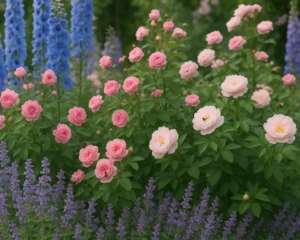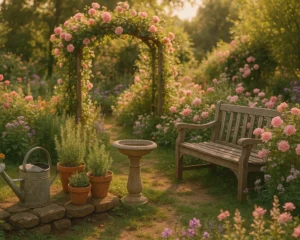There’s something magical about a cottage garden — that seemingly effortless abundance of flowers spilling over pathways, climbing up trellises, and filling every corner with color and fragrance. If you’ve ever dreamed of creating your own whimsical outdoor haven, you’re in good company. According to Yardzen’s 2025 Trend Survey, cottage gardens are the most wanted landscaping style of the year, and it’s easy to see why.
Unlike formal gardens that demand precision and constant maintenance, cottage gardens embrace a more relaxed, romantic approach. They’re gardens with soul — places where roses tumble over fences, where bees hum among the lavender, and where every season brings new surprises. Best of all, creating a cottage garden is more accessible than you might think. Let’s explore how you can transform your outdoor space into a charming retreat that looks like it’s been growing wild for generations.
The Timeless Appeal of Cottage Gardens
Cottage gardens originated in rural England, where working families grew vegetables, herbs, and flowers together in small plots. What began as practical necessity evolved into a distinctive aesthetic — one that values abundance over order, diversity over uniformity, and natural beauty over formal design. Today’s cottage gardens honor this heritage while adapting to modern lifestyles and environmental concerns.
The appeal of cottage gardens lies in their authenticity and warmth. They feel lived-in and loved, not staged or sterile. Walking through a cottage garden is like stepping into a storybook — there’s always something new to discover around each bend in the path. The style welcomes imperfection, celebrates seasonal change, and creates habitat for pollinators and beneficial insects. In our fast-paced world, cottage gardens offer a peaceful retreat where you can slow down, connect with nature, and cultivate beauty with your own hands.
What makes cottage gardens particularly relevant in 2025 is their sustainability. According to Garden Design’s 2025 trends, gardeners are increasingly focused on native plants, pollinator support, and low-maintenance landscapes — all principles that cottage gardens naturally embrace. When you plant a cottage garden, you’re not just creating beauty; you’re supporting local ecosystems and reducing your environmental footprint.
Essential Elements of Cottage Garden Design
Creating a cottage garden doesn’t require following strict rules, but certain elements help capture that characteristic charm and abundance.
Layered, Abundant Plantings
The signature look of cottage gardens comes from layered plantings that create depth and visual interest. Think of your garden in three tiers: tall plants like delphiniums, hollyhocks, and climbing roses in the back; medium-height perennials like peonies, roses, and catmint in the middle; and low-growing plants like lavender, dianthus, and creeping thyme in front. This layering ensures that something is always blooming at eye level, creating that lush, overflowing effect.
Don’t be afraid of abundance. Cottage gardens thrive on generosity — plant in drifts and clusters rather than single specimens. Let plants mingle and self-seed. Allow some controlled chaos. The goal is a garden that looks like it grew itself, even though you’re carefully orchestrating the beauty behind the scenes.
Classic Cottage Garden Plants
While any plant can find a home in a cottage garden, certain classics define the style. Roses — especially old-fashioned varieties and climbers — are quintessential. Delphiniums provide vertical drama with their towering spires of blue, purple, or white blooms. Foxgloves add height and whimsy. Lavender brings fragrance and attracts pollinators. Peonies offer lush, romantic blooms in late spring.
Don’t forget herbs and edibles, which honor the cottage garden’s practical roots. Rosemary, thyme, and sage add fragrance and texture while serving culinary purposes. Vegetables like runner beans can climb decorative trellises, and edible flowers like nasturtiums and calendula add both beauty and function. This mix of ornamental and edible plants creates a garden that feeds both body and soul.
Charming Hardscape and Structures
Cottage gardens benefit from thoughtful hardscape elements that provide structure and charm. Winding stone or gravel pathways invite exploration and create a sense of journey through the garden. Rustic wooden fences, arbors, and trellises give climbing plants places to ramble while adding vertical interest. A weathered garden bench tucked among the flowers creates a perfect spot to sit and enjoy your handiwork.
Look for materials that age gracefully — natural stone, weathered wood, vintage terracotta pots, and galvanized metal watering cans. These elements should feel like they’ve been part of the garden for years, developing patina and character over time. As we explored in our article about upcycling and creating high-end looks for less, thrifted and repurposed items often bring the most charm to outdoor spaces.
Starting Your Cottage Garden Journey
Creating a cottage garden is a journey, not a destination. Unlike instant landscapes, cottage gardens develop character and beauty over time as plants mature, self-seed, and find their perfect spots.
Begin with Good Bones
Start by establishing the structure of your garden — pathways, beds, and any hardscape elements. Even informal cottage gardens benefit from good bones that guide the eye and create a sense of flow. Sketch out where you want paths to meander, where you might place an arbor or trellis, and how you’ll define planting beds. These structural elements will anchor your garden as it fills in and matures.
Consider your garden’s exposure and microclimates. Cottage gardens can thrive in full sun or partial shade, but plant selection will vary based on conditions. Most classic cottage plants prefer at least six hours of sun, but shade-tolerant options like hostas, astilbe, and bleeding heart can create cottage charm in shadier spots.
Choose Plants Wisely
Select plants that suit your climate and growing conditions. While traditional English cottage gardens inspire the aesthetic, you’ll have better success choosing plants adapted to your region. Many areas have native plants that capture cottage garden charm while requiring less water and maintenance. Your local extension office or native plant society can provide excellent guidance.
Start with perennials that will return year after year, building the foundation of your garden. Add annuals and self-seeding flowers to fill gaps and provide continuous color. Don’t try to plant everything at once — cottage gardens develop over seasons and years. Begin with a few key plants, observe how they perform, and add more as you learn what thrives in your space.
Embrace the Process
Cottage gardening is as much about the journey as the destination. You’ll learn by doing — discovering which plants thrive in your conditions, where volunteers pop up, and how colors and textures work together. Some plants will exceed expectations; others may disappoint. This is all part of the process.
Allow yourself to experiment and make mistakes. Move plants that aren’t happy. Divide perennials that outgrow their space. Let some flowers self-seed in unexpected places. The most charming cottage gardens have an element of serendipity — happy accidents that you couldn’t have planned but that add to the garden’s unique character.
Living with Your Cottage Garden
A cottage garden isn’t just something to look at — it’s a space to live in and with. These gardens invite interaction, whether you’re cutting flowers for the kitchen table, harvesting herbs for dinner, or simply wandering the paths with your morning coffee.
Maintenance in a cottage garden differs from formal landscapes. Rather than rigid schedules and perfect edges, cottage gardens ask for attentive observation and gentle guidance. Deadhead spent blooms to encourage more flowers. Stake tall plants before they flop. Pull weeds when they’re small. But also embrace a bit of wildness — self-seeded volunteers, plants leaning on each other, and the occasional weed that adds unexpected charm.
Throughout the seasons, your cottage garden will offer different gifts. Spring brings bulbs and early perennials. Summer explodes with roses and delphiniums. Fall offers late-blooming asters and sedums. Even winter has beauty in dried seedheads and evergreen structure. This ever-changing nature keeps cottage gardens endlessly interesting and deeply connected to the natural rhythms of the year.
Creating a cottage garden is an act of optimism and creativity — a belief that beauty matters, that nature deserves support, and that our outdoor spaces should nourish our souls as much as our eyes. Whether you’re transforming an entire yard or creating a small cottage-style border, you’re cultivating more than plants. You’re creating a haven where you can connect with the earth, support pollinators, and surround yourself with beauty that you helped bring into being.
Your cottage garden awaits, ready to unfold its magic season by season, year by year. All it needs is your vision, your hands, and your willingness to let nature be your co-creator in this beautiful, ongoing collaboration.



